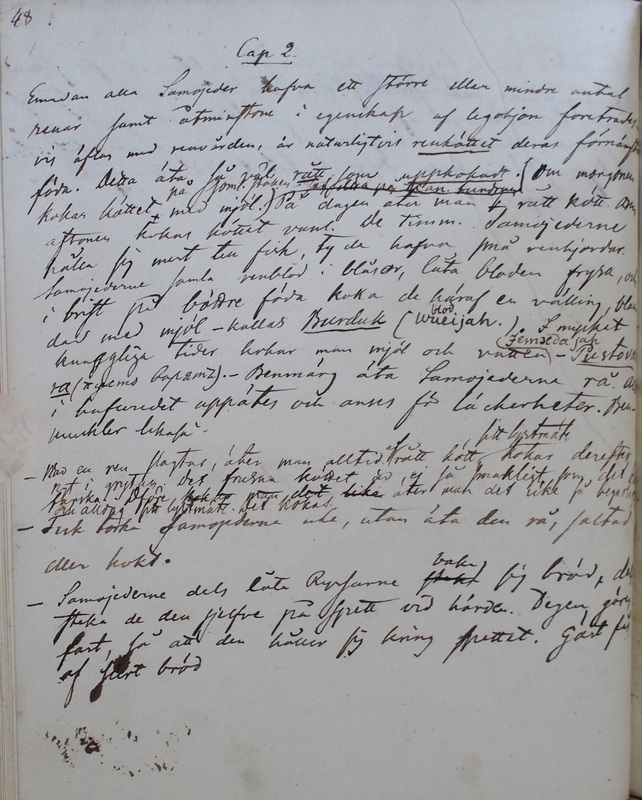Ethnographiska, historiska och statistiska anmärkningar. 048
Title
Ethnographiska, historiska och statistiska anmärkningar. 048
Description
|
Cap 2.
In the following two pages, Castrén describes Nenets diet. It relies on flexible and context-dependent consumption of fish, birds, and reindeer. While birds are always eaten cooked, reindeer and fish are also eaten raw, both warm and frozen. For example, Kušelevskij (1868) describes Nenets food consumption in the mid-19th century.
|
Chapter II |
| Emedan alla Samojeder hafva ett större eller mindre antal renar samt åtminstone i egenskap af legohjon företrädes- vis äfven med renvården, är naturligtvis renköttet deras förnämsta föda. Detta äta så väl rått,
som uppkokadt. (Om morgonenTN ңайбарць ʻto eat raw reindeer meat’; пиревы ңамза ʻcooked meat’.
kokas köttet med mjöl på soml[iga]. ställen <--> på Kan[inska]. tundran) På dagen äter man råt kött. Om aftonen kokas köttet vanl[igtvis]. De Timm.[Timanska] Samojederne håller sig mest till fisk, ty de hafva små renhjordar. Samojederne samla renblod i blåsor, låta bloden frysa, och i brist på bättre föda koka de häraf en välling, blan- dad med mjöl - kallas Burduk
In Siberia and the Arkhangel’sk region the Ru burduk (burda) refers to a meat soup thickened with a considerable amount of flour, Russian salamata, TN я. А bouillon with meat, TN евей. (Dalʹ 1994a: 349; Dal’ 1994b: 12; Chomič 1966: 134)
(blod wueijah.)
I mycketTN вэя ʻblood’
knusgliga [knussliga] tider kokar man mjöl och vatten jemzeda jah
- Purstovae-TN ңамзасяда я ʻmeatless soup’.
ra (пусть варятъ). Benmärg
äta Samojederna rå. AlltTN хэва ʻmarrow’
i hufvudet uppätes och anses för läckerheter. Ben muskler likaså. |
Because all Samoyeds have a greater or lesser number of reindeer, including those who work as a hired hand, which is also common in reindeer husbandry, reindeer meat is naturally their principal food. It is eaten raw as well as cooked. (In the morning the meat is cooked with flour (in some places <--> in the Kanin tundra.) During the day, the meat is eaten raw. In the evening the meat is usually cooked. The Timan Samoyeds rely mostly on fish, because they have small reindeer herds. The Samoyeds collect reindeer blood in bladders, let the blood freeze, and in the event of a lack of better food, they cook a gruel of the blood mixed with flour – called Burduk. During very hard times, they use flour and water to make jemzeda jah – Purstovaera (pustʹ varjatʹ). The Samoyeds eat bone marrow raw. Everything in the head is eaten and considered a delicacy. Leg muscles as well. |
| När en ren slagtas, äter man alltid af rått kött sitt lystmäte, kokar derefter, ngt[någonting] i grytan. Det frusna köttet är ej så smakligt som det färska. D[er]före kokar man det like äter man det icke så begeistrad och alldrig sitt lystmäte. Det kokas. |
When a reindeer is slaughtered, they always eat their fill of the raw meat, after which some is cooked in a cauldron. The frozen meat is not as tasty as fresh. Therefore they do not eat it as eagerly and never eat their fill of it. It is cooked. |
|
Fisk torka
Samojederan inte, utan äta den rå, saltadThe Nenets do dry fish and eat it as it is (TN пэхэ) or cooked in fish fat (TN порца).
eller kokt. |
The Samoyed do not dry fish, but they eat it raw, salted, or cooked. |
| Samojederne dels låta Ryssarne baka sig bröd dels steka de den sjelfve på spett vid harden.
Degen göresTN нянь ʻbread’ refers to the bread formerly bought from the Russians. Bread baked in the fire is called леска or реска, and it can be made flat or in the shape of a baguette. On Kolguev Island, the bread was baked in ovens. (Chomič 1966: 137)
fast, så att den håller sig kring spettet. Gäst fås af surt bröd. |
The Samoyeds partly have the Russians bake bread [for them], and partly they fry it themselves on a bread pole by the hearth. The dough is made firm so that it stays around the pole. Guests are served sour bread. |

